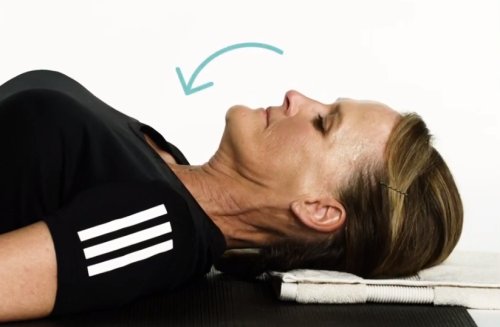Exercises For Neck Pain Can Help Strengthen Weak Muscles Related To Ongoing Neck Pain And Poor Posture
We began the neck exercises with the initial movements related to poor neck posture by learning how to regain the normal position of the head over the neck which involved retracting the neck and shoulders. Here we address more exercises for neck pain that can be a key element in actively reducing pain and dysfunction as well as prevention.
 These exercises for neck muscles were to be practiced until you felt comfortable in the position and pain decreased before moving on to the next in the series of exercises involving neck stretches. The stretches should not produce neck pain or increase discomfort.
These exercises for neck muscles were to be practiced until you felt comfortable in the position and pain decreased before moving on to the next in the series of exercises involving neck stretches. The stretches should not produce neck pain or increase discomfort.
The first 2 neck exercises should be done for a few weeks or more resulting in decreased levels of pain and an awareness of correct neck posture.
The next stage to begin will help to strengthen the neck muscles which are known to be weak and related to problems with pain. You should not stop the prior two exercises and they should be done daily depending on your activities.
The most important neck muscles that require exercises are the extenders located in the back of the neck. We have illustrated these muscles in accordance neck strain and related issues. Technically, the splenius capitis, and semispinalis capitis and cervicis muscles are mainly responsible for head extension and form certain areas of strain and pain radiation as we have detailed from poor posture in holding the head forward for long periods of time.
Now we can begin to strengthen the muscles most often associated with neck pain. These exercises may produce some discomfort but should not cause any sharp or increase in pain.
 The first way to perform exercises for neck pain is to lay on the floor or stand up against a wall observing correct posture as illustrated. While maintaining the proper neck curve, press your head into the floor or wall. The floor should be carpeted. Do not strain and do not do the retraction motion from the first set of exercises prior to pressing. Hold for a few seconds then release.
The first way to perform exercises for neck pain is to lay on the floor or stand up against a wall observing correct posture as illustrated. While maintaining the proper neck curve, press your head into the floor or wall. The floor should be carpeted. Do not strain and do not do the retraction motion from the first set of exercises prior to pressing. Hold for a few seconds then release.
These exercises are not high tech or complicated, but they can work based on your determination to work on the quality of the motion and diligent practice. Do a few repetitions once or twice a day for the first day or two.
You must gauge yourself on what you feel is appropriate for you. These exercises for neck pain can be slowly increased for either the time you press, the force you press with or both. Remember, never strain, this is not a contest. We want to slowly build new patterns of strength and motion over weeks and months for a lasting effect with reduced instances of pain.
A 2018 study in Physiotherapy Theory & Practice indicated this exercise was beneficial for improving pain, restoring normal neck curve and improving function among patients with chronic neck pain. Watch the video below to get started.
The neck exercisers are tools that are designed to these exercises effectively and provide comfort for the head and a consistent resistance of force. Better results are usually obtained using well designed exercise equipment that is easy and convenient and they allows you to perform exercises for neck pain with greater reliability and better results.
A 2016 study in the Journal of Rheumatology found postural exercises were effective in significantly reducing pain at 3 weeks and on, and a neck support pillow at 12 weeks and on. The authors indicated, “These interventions could be beneficial in reducing neck pain symptoms.”












